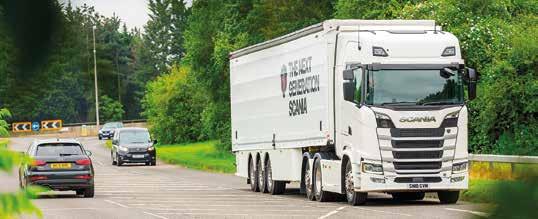
4 minute read
Scania S650 Provides a Consistent Drive

Photos by Tom Lee
To get the most from a truck fitted with an automated manual transmission you need the added extras to increase and maintain performance. Kevin Swallow took Scania’s new S650 on the road to see how easy it is to achieve consistency.
Last year Scania introduced a new generation of Euro-6 V8 engines. The new addition in that line up was the 650hp, to go with the 520, 580 and 730hp. Scania duly claimed that these could help generate a ‘7-to-10% reduction in fuel consumption’. The V8 has proved popular in the 49 years it has been around but to get consistent results from it no longer can you simply stick the truck in auto and let it go. To get a consistent performance you need subtlety. Things like the Scania Active Prediction (SAP), which uses GPS (global positioning system) to assess the topography of the road ahead, and quicker gearchanges when accelerating. For the latter Scania has made the latest layshaft brake system in automated manual transmissions (AMTs) for Opticruise quicker by using synchro rings to harmonise the different speeds of the countershaft and main shaft in the gearbox when changing up the box. It shortens the actual gearshift time and lessens the dip in turbo pressure. For Export & Freight, Scania provided a S650 6x2 with a tag axle and Highline all-new flat-floor sleeper. The driveline is the 16.3-litre DC16 V8 with Scania XPI fuel injection, and achieving Euro-6 via selective catalytic reduction (SCR). Although badged at 650, its true horsepower rating is 642hp at 1,900rpm with 3,300Nm torque levels that match the 520hp and 580hp. Turning power into motion is the 12-speed transmission with automated change. It’s an overdrive box, with 0.8-to-1 for top gear, and it has a 3.08:1 rear axle ratio. To slow momentum its fitted with full EBS and Advanced Emergency Braking to support the disc brakes. Secondary braking includes an exhaust engine brake rated at 297kW at 2,400rpm, and Scania hydraulic retarder that achieves up to 4,100Nm. From Milton Keynes we used Scania’s own test route that takes in the M1 from J14 north to J21, onto the M69 towards Coventry, then back down the A5 through Towcester into Milton Keynes; a total of 172kms.
Driver Support
Scania’s driver trainer suggested we put the truck into ‘auto’ and let four Scania Driver Support measurement tools assess my driving skills through hill climbing, braking, anticipation and engine revs. Anyone who’s driven a Euro6 Scania will be familiar with at least three of these. The new addition is ‘braking’.
Introduction of the flat-floor puts in an exclusive club with MAN, Mercedes-Benz and Renault Trucks.

A star-rating system measures each action; five for a good piece of driving and zero for bad. That score is transferred to a rolling percentage score. Easiest to get 100% is engine revs, only a deliberate attempt to rev outside of the appropriate green zones will inflict damage. Anticipation requires taking your foot off the gas then after five seconds deploy a method of braking for top marks. The new ‘braking’ support system is a little more difficult. It requires the driver to use the engine brake and/or retarder to slow the vehicle as much as is possible before using the foot brake to bring the truck to a halt. Not as easy as it sounds. The driver needs to meet the anticipation requirements and have enough road space to deploy secondary braking ahead of a roundabout or traffic lights. Jumping on the foot brake to predominately slow the truck leads to a lower score. However, the toughest remains hill climbing. In cruise SAP does all the work, switch to the accelerator it’s down to you and judging the terrain. The truck still reads the road ahead; accelerate to the brow of the hill it’ll advise you to take your foot off the gas. Failure to comply leads to a lower score. With so much power and torque available the aptitude of the S650 is not in doubt. For the most part that impressive oomph is latent as the truck uses SAP to roll over the undulating terrain. If it’s not a contradiction in terms, we selected ‘economy’ mode on this route that meant the use of power was moderated, with Scania claiming this helps to reduce fuel use by up to 2%. When called upon the truck likes to use torque rather than power to cope with most hill climbs. The engine will happily lug down to the bottom end of its torque plateau, which covers 950-to-1,350rpm. When a gearchange is required, the action is smooth, quick and responsive. It being a V8, it is in these situations that the traditional growl from the driveline, thanks to its V8 firing sequence, penetrates the cabs improved noise insulation.
Spacious Cab
Inside the Highline cab, the vast amount of space is the most obvious thing. The introduction of a flat floor to the Scania brings the whole design up a notch. The driver has 2,070mm internal height, plus 1,460mm above the only bunk fitted. With storage lockers above the windscreen, and on the backwall and underneath the bunk, it’ll keep any tramper happy. A plush finish with leather seats and trim make it more penthouse than bedsit. This truck oozes power and comfort. The benefits of running a modern-day commercial vehicle with AMT supported active prediction and live driver support function is more consistency by the driver, which in turn reduces the running costs like prolonged service life of brake pads and improved fuel consumption.











